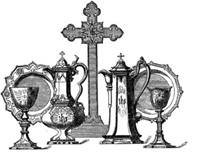
An Apologia for Fr. Pierre-Jean De Smet
THE BLACK-ROBED DEFENDER OF NATIVE AMERICANS
In 2015 a statue of Fr. Pierre-Jean De Smet (1801-1873) at St. Louis University was removed from its prominent position in front of a residence hall and carted off to the university’s museum. It was the centerpiece of an installation called Where the Rivers Meet, sculpted by an unknown artist in the 19th century and placed in front of Fusz Hall in the 1950s, depicting De Smet holding aloft a crucifix, and two Native Americans, one kneeling, in awe before it. The installation had aroused the anger of progressive students and faculty, prompting an op-ed in the school newspaper, written by a student leader, advocating the statues’ removal because they depict “a history of colonialism, imperialism, racism and of Christian and white supremacy” (The University News, April 23, 2015). The removal of Where the Rivers Meet started a process that culminated in 2020 with the toppling and desecration of numerous statues across the nation, including those of Christopher Columbus, George Washington, St. Junípero Serra, the Virgin Mary, and many others.
Fr. De Smet is a man few people have heard of. Born in 1801 in present-day Belgium, De Smet, desiring to be a missionary, immigrated to the United States in 1821. He entered the Jesuit novitiate near Baltimore, Maryland, and in 1823 traveled west to Florissant, Missouri, near St. Louis, where he helped establish a mission to the Indians. De Smet was a key figure in the establishment of St. Louis College (presently St. Louis University), where he served as dean and instructor. He was ordained a Jesuit priest in 1827.
In the following years, De Smet traveled throughout the American West, establishing numerous missions to the Indians, including St. Joseph’s (to the Potawatomie) near present-day Council Bluffs, Iowa, and St. Mary’s (to the Flatheads) near Missoula, Montana. He oversaw the negotiation of dozens of peace treaties among the native tribes and became their most trusted advisor, even meeting with the great Indian leader Sitting Bull. The U.S. government regarded him as an expert on the tribes of the Great Plains and sought his help in negotiating the treaties executed at Fort Laramie, Wyoming, in 1851 and 1868.
Fr. De Smet gained notoriety when Oregon Missions, a collection of his letters to friends and family, was published in 1847. His analysis of the geology and fauna of the area was reminiscent of Lewis and Clark and was a hit with the American public starved for information about the West.
You May Also Enjoy
Jesuit missionaries left reports on the martyrdoms of many Native American converts to Catholicism. Not one has been canonized.
The time is ripe to reconsider the trajectory of our nation, and how Catholics fit into it. To that end, we asked thinkers of different stripes four questions.
When faith is restricted to "personal" matters, it becomes socially retrograde and politically irrelevant, the possession of civil idiots.

